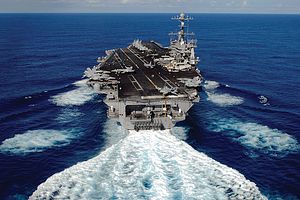The Chinese government has cancelled a scheduled port visit to Hong Kong by the U.S. Navy’s Nimitz-class nuclear-powered supercarrier, USS John C. Stennis, without explanation, the South China Morning Post reports.
The Chinese Foreign Ministry informed the United States of its decision last Thursday, according to a Chinese official. “[The ministry] needs to approve every ship coming into Hong Kong. [They] said ‘no’ to the carrier,” the official said.
An unnamed U.S. Navy official told the Navy Times that the U.S. consulate in Hong Kong was informed by Chinese officials that the timing of the ship’s visit was “inconvenient” for China. The U.S. consulate had to cancel a number of public tours of the aircraft carrier.
Four accompanying U.S. Navy ships were also denied access.
The ongoing port call of the Blue Ridge-class command ship, USS Blue Ridge, the floating headquarters of the U.S. Navy’s Japan-based 7th Fleet, appears to be unaffected by China’s recent decision.
“We were recently informed that a request for a port visit by a U.S. carrier strike group, including the USS John C. Stennis and accompanying vessels, to Hong Kong was denied,” a Pentagon spokesman said.
“We have a long track record of successful port visits to Hong Kong, including with the current visit of the (command ship) USS Blue Ridge, and we expect that will continue.”
China has refused U.S. Navy ships access to its ports in the past. In 2007, the Oliver Hazard-Perry-class guided-missile frigate USS Reuben James—sunk off Hawaii in January 2016—was refused entry. Also in 2007, the USS Kitty Hawk carrier strike group (CSG) was denied access.
During a port call, given a Nimitz-class aircraft carrier’s deep draft, the ship usually has to anchor offshore with ferries going back and forth between the vessel and the shore ferrying sailors ashore.
The USS John C. Stennis CSG has been conducting routine operations in the South China Sea launching hundreds of sorties while in the contested waters (See: “US Carrier Strike Group Arrives in South China Sea to Deter China”). In April, U.S. Defense Secretary Ashton Carter, along with Philippine Secretary of National Defense Voltaire Gazmin, visited the USS John C. Stennis while operating in the South China Sea.
“We want to reduce tensions, but we also want everybody in the region to be able to rise and develop in their own way — including the Philippines, by the way, which happens also to be a longstanding and very staunch treaty ally of the United States,” Carter told reporters while aboard.
Over the last couple of months, the United States has conducted a number of naval patrols in the South China Sea.
Last week, the United States also dispatched A-10C Thunderbolt II aircraft and HH-60 Pave Hawk helicopters near Scarborough Shoal, 120 nautical miles off the coast of the Philippines’ Luzon Island, to demonstrate its commitment to the Philippines, which lays claim to Scarborough Shoal and had administered it until 2012, when China seized the feature by force. Now China appears to be getting ready to launch a land reclamation campaign on Scarborough Shoal.
As my colleague Ankit Panda explained, the Philippines have taken China to court over the South China Sea disputes, including Scarborough Shoal:
The Philippines has filed a case against China at the Permanent Court of Arbitration (PCA) in The Hague. The PCA is expected to reach a verdict in Philippines v. China in either late May or June this year and, where it has jurisdiction, the ruling is expected to go in Manila’s favor. China has said that it does not recognize the validity of the case and has refused to participate.
In 2007, the USS Reuben James and USS Kitty Hawk CSG were denied access to Chinese ports just around the time when U.S. President George W. Bush met the Dalai Lama and concluded a major arms sale with Taiwan. However, the USS Kitty Hawk was allowed to dock in Hong Kong five months later once Sino-U.S. ties normalized.
































